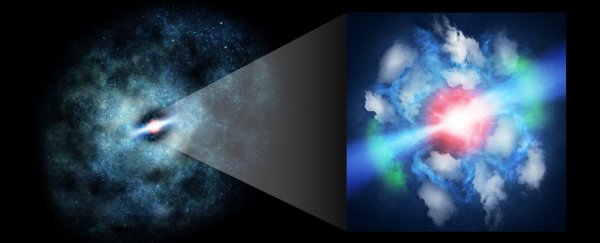In the far reaches of the Universe, astronomers have managed to capture a rare interaction. As a supermassive black hole ravenously slurps down matter around it, it's sending out jets of plasma - pushing into and heating the gas in the galaxy around it.
This is difficult to capture at the best of times, but this case was a particularly impressive feat. The galaxy in question is a whopping 11 billion light-years away - when the Universe was less than 3 billion years old.
It's called MG J0414+0534, and astronomers managed to capture it in detail because of gravitational lensing. In between us and the galaxy is a different, rather massive galaxy whose gravity distorts the path of the light travelling from behind it, creating four images of MG J0414+0534 around it (see image below).
"This distortion works as a 'natural telescope' to enable a detailed view of distant objects," said astronomer Takeo Minezaki of the University of Tokyo in Japan.
 The lensed quasar. (ALMA (ESO/NAOJ/NRAO), K. T. Inoue at al.)
The lensed quasar. (ALMA (ESO/NAOJ/NRAO), K. T. Inoue at al.)
And this can show us how some galaxies evolved in the early Universe.
Black holes - and in particular the supermassive black holes that power galaxies - are extraordinarily complex things. They're so dense, their gravitational power creates a point of no return around them: a boundary called the event horizon, beyond which not even light speed is sufficient to achieve escape velocity. We can't, therefore, see into a black hole.
But outside the event horizon - that is, the part we can see - is an incredibly extreme environment. The most extreme example is a quasar, an active galactic nucleus with a supermassive black hole in the centre. These are the early, violent stages of a galaxy's life, with the black hole actively feasting on the material around it.
This spews out intense light across the electromagnetic spectrum as the accretion disc of material swirling around and into the black hole generates intense light and heat through friction. Quasars are among the brightest objects in the Universe.
But that's not all. These active black holes also have jets of ionised material that spew forth from their polar regions at relativistic speeds - comparable to the speed of light. These don't come from inside the black hole; it's thought that the material is channelled from the inner edge of the accretion disc along the black hole's magnetic field lines outside the event horizon to the poles, where it's ejected at high speed.
In turn, those jets can blast into the black hole's galaxy, blowing away the clouds of dust and gas that would otherwise collapse into stars - effectively turning off star formation, a phenomenon known as quenching.
Most older galaxies are quenched, and astronomers are still figuring out the mechanisms whereby this can occur. One of these mechanisms is quasar winds. The jets could be contributing, too.
It's known that MG J0414+0534 has bipolar jets shooting from its black hole. By combining the four lensed images of the galaxy, and subtracting the gravitational effects of the galaxy in front, the team was able to reconstruct an image of these jets.
 (ALMA/ESO/NAOJ/NRAO/ K. T. Inoue et al.)
(ALMA/ESO/NAOJ/NRAO/ K. T. Inoue et al.)
Above: Reconstructed images of what MG J0414+0534 would look like if gravitational lensing effects were turned off. The emissions from dust and ionised gas around a quasar are shown in red. The emissions from carbon monoxide gas are shown in green, which have a bipolar structure along the jets.
"Combining this cosmic telescope and ALMA's high-resolution observations, we obtained exceptionally sharp vision, that is 9,000 times better than human eyesight," said astronomer Kouichiro Nakanishi of the National Astronomical Observatory of Japan/SOKENDAI.
"With this extremely high resolution, we were able to obtain the distribution and motion of gaseous clouds around jets ejected from a supermassive black hole."
As the black hole jets slam into the gas of the interstellar medium, the impact creates heat. From this heat map, the researchers were able to calculate that the gas clouds were moving at speeds up to 600 kilometres per second (373 miles per second).
Moreover, both gas clouds and jets were relatively small for a galaxy of this type, indicating that we're observing a very early stage in jet formation - as early as a few tens of thousands of years. This means it could be very important for understanding how galaxies become quenched.
"MG J0414+0534 is an excellent example because of the youth of the jets," said astronomer Kaiki Inoue of Kindai University in Japan.
"We found telltale evidence of significant interaction between jets and gaseous clouds even in the very early evolutionary phase of jets. I think that our discovery will pave the way for a better understanding of the evolutionary process of galaxies in the early Universe."
The research has been published in The Astrophysical Journal Letters.
